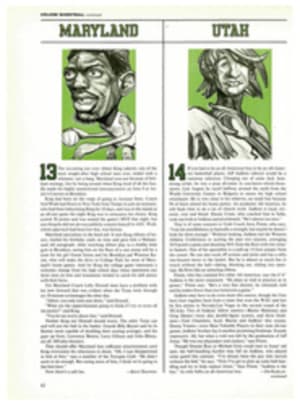
DESPITE WINTER'S CHILL, ANGLING FOR WEAKFISH IS THE LOW-COUNTRY HIGH
I know I am home now. For a while, there was some doubt, a dread suspicion that Thomas Wolfe was right. In some ways, he was, I suppose, but now the salt wind coming off the marshes is cutting right through my slicker and chamois shirt and touching something deep inside me.
My fingers are numb with the cold, numb as they have not been for years. The closest thing to it that I have experienced recently was the iciness of spring mornings fly-fishing along Connecticut's Housatonic River or in small streams in Dutchess County, N.Y.
That kind of fishing was an alien sport, something acquired from Abercrombie & Fitch. It went with the house in Connecticut, the station wagon and the Brooks Brothers suits. Had you looked for my soul, you would have found it here in the creeks and marshes of the South Carolina low country.
There are countless recollections of the low country lodged in my mind: crabbing with handline and dip net along tidal creeks; fly-fishing for bass and bream in the geometrical canals of fallow rice fields; casting for lumbering channel bass in the warm October surf at Cape Romain; shooting doves in autumn fields; and following a liver-and-white pointer bitch named Mary through frozen sedge for bobwhite quail.
But none of them is as fondly remembered as fishing for speckled trout. It is our trout fishing. They are not truly trout, of course. They are weakfish (named for their tender mouths, not for any lack of fighting ability), members of the croaker family. Cynoscion nebulosus. The spotted weakfish. Sometimes we would hook into one of their northern cousins, Cynoscion regalis, the common weakfish.
The fish never stray far from the low country. In summer they cleave to the deeper waters offshore or in the sounds. There is a period in deep winter, too, when they slip back into the sea. But in late October, when the tepid waters of the creeks and rivers cool down, the weakfish come in marauding packs. It is when they are schooling like this that angling for them becomes a passion for the low-country fishermen.
My father was one of the preeminent fishermen of Beaufort County. From his earliest days in Port Royal until he died in 1960, most of his waking moments were filled with schemes to go fishing. For that reason, the nomadic life of the insurance agent suited him perfectly.
In the trunk of his car was a baggy Army field jacket, a pair of oversized trousers, two huge rubber boots, a tackle box and a rod and reel. If he had an hour to spare, he rushed to the nearest creek, slipped the oversized clothing on top of his business suit and fished.
If Daddy was a hell of a fisherman, he was also hell on equipment. For reasons I still cannot fathom, he never made the connection between salt water and corrosion. Reels went unrinsed and frequently froze solid. To be within earshot of my father then, or when he got a backlash in his line, was to broaden one's knowledge of language considerably.
Daddy found that railroad trestles frequently provide access to good trout-fishing holes that otherwise could be reached only by boat. In the lean war years we did not own a boat, so we frequently fished from these spans. One of our favorites during our brief residence at Lobeco (where my mother was principal of the three-room school) was the Seaboard Airline trestle. I recall memories of it: setting dynamite blasting caps on the rails to signal engineers to slow down for a message from Grady Byers Johnson's dad, the local telegrapher, and, feeling that faint vibration in the rails, exchanging glances with Daddy and hightailing it down the crossties behind him—our rods and bait buckets clanking wildly—to safety before the Orange Blossom Special thundered by.
Fishing for speckled trout, as has been noted by Henry Lyman and Frank Woolner in their classic, The Complete Book of Weakfishing, is a mania that draws devotees from hundreds of miles away. When the big runs began in the creeks and rivers that spread like fingers from Port Royal and St. Helena sounds, my father flashed the word to selected relatives. Overnight our house on Pigeon Point in Beaufort became a makeshift lodge. Uncle Boots and Aunt Helen came down from Sullivan's Island. Uncle Charles (he was a traveling salesman, which may help to explain why he was the first member of our staid, somewhat Norman Rockwellian family to indicate to me—much to my father's distress—that being girl-crazy was normal) and Aunt Bryte cruised down from Charlotte in their Oldsmobile sedan. Rollaway beds and cots were strewn about the living room, and bourbon-bruised tenors sang into the night. Never before or since have I heard such a cacophony of snores.
Despite the drinking, all of us would be up at first light. We would struggle into long johns and rubber boots and be off to whatever creek bend, hole, trestle or shrimp-boat dock was deemed the hottest spot at the moment. The car would be filled with muffled coughs, clouds of smoke from Philip Morrises and Lucky Strikes and the aroma of Uncle Boots' beloved Limburger cheese, which for years I thought was a dead shrimp left under the seat by my father.
For the most part, we used what remains the preferred method for catching speckled trout: a live shrimp on about 18 inches of leader material dangling below a swivel sinker and a cork float. Ideally, the live bait was floated about an inch or two above the bottom. To achieve that, the float was made adjustable by means of a plastic bead and a piece of rubber band tied around the line. By sliding the rubber band knot up or down, you could alter the depth at which the shrimp hung.
Minnows are almost equally effective as live bait and a damned sight cheaper to obtain and keep alive. Shrimp are exceedingly delicate and must be kept in freshly aerated salt water.
Daddy had several minnow traps set all that time. They were always placed in small, brackish feeder streams, strategically located to keep him within a short haul of fresh bait. Nothing infuriated him more than to have a trap stolen or robbed of its contents.
Speckled trout are terrific fighters when hooked and delicious to eat, but they are extraordinarily sullen and finicky about what they eat. They are very sensitive to temperature changes and, as a result, they prefer to spend the hottest summer months (and coldest winter ones) in deep holes where the temperature is relatively stable. In early summer they spawn, usually in the deepest sounds and rivers.
As young fish (they mature at about age three) they tend to run in schools. As older fish (few males seem to live beyond four) they tend to be solitary, but will gang up in rapacious schools during sudden temperature drops. These rapid decreases can also have a deleterious effect. If a trout is in shallow water at the time, it becomes virtually immobilized, rendering it easy prey for man and beast.
And speckled trout are at once attracted to and repelled by noise. It depends on the nature of the sound. Bang an oar against the bottom of your boat or dump your anchor with a loud splash, and you may as well move on to the next drop. But the fish seem to be attracted to surface splashes. A time-honored technique of angling for speckled trout with the cork bobber calls for frequent (every 15 seconds or so) popping of the cork by raising the rod tip smartly. This serves two purposes: it animates the bait and makes a noise that the fish are drawn to.
In later years, having served my journalistic apprenticeship on the Beaufort Gazette and moved on to Charleston to further my newspaper career, my views on speck fishing were widened by a meeting with the inimitable Jake Jones.
Born a Tar Heel—and in the central, red-clay district of North Carolina, at that—Jake had come to the low country as a young man, caught his first speck and never seriously considered doing anything else. He was (or is—I've long since lost track of him) a guide. He was also a purist. No live bait. And no booze.
If ever a man could be considered an artist with a bucktail jig, it was Jake. All those years with my father and my uncles were merely a prep course for the hours I spent with Jake. He taught me to manipulate a bucktail—an inanimate hunk of lead, steel and hair—so that it imitated whatever the trout were feeding on. The first fish caught always was disemboweled to study that day's feeding. Jake also taught me to read the tidal rips and eddies of the Cooper and Wando rivers. Without Polaroid glasses or fathometers or other modern fishing aids, Jake could always put you on a speck.
"There," he'd say, pointing to a barely perceptible change in the creek's surface. "Right in that eddy. He's laying there with his head into the tide. Now flip your bucktail six feet beyond and let it sink a little."
So, I stand now in the bow of a wave-lapped whaler. The wind is blustery and from the west. Tonight it will swing to the north, and the temperature will plunge into the 30s. It is December; winter has come to the low country. Tomorrow the fish may be back in the deep holes or cruising the bottoms of the sounds. Today they are in a feeding frenzy. The marsh whips before the wind, and the tide, even here in the creek, is slashed to a foaming chop. Leaden winter clouds line the horizon. "Bluebird weather is for bluebirds." A voice from the past. Jake Jones lives.
Beside me is an awkward adolescent, all arms, legs and bottomless stomach. Blond hair stubbornly long. The first stains of acne march across his mother's chin. Impatiently he submits to being told how to thread a live shrimp on a hook. He knows how to cast, thank you. Or no thanks. Curtly. His brown eyes brighten, barely concealing his delight in his perfect placement of the float. I watch it bob and weave before the contrary pressures of tide and wind, slowly wending down stream. Any second now. Any second and the circle will be complete.
ILLUSTRATION

